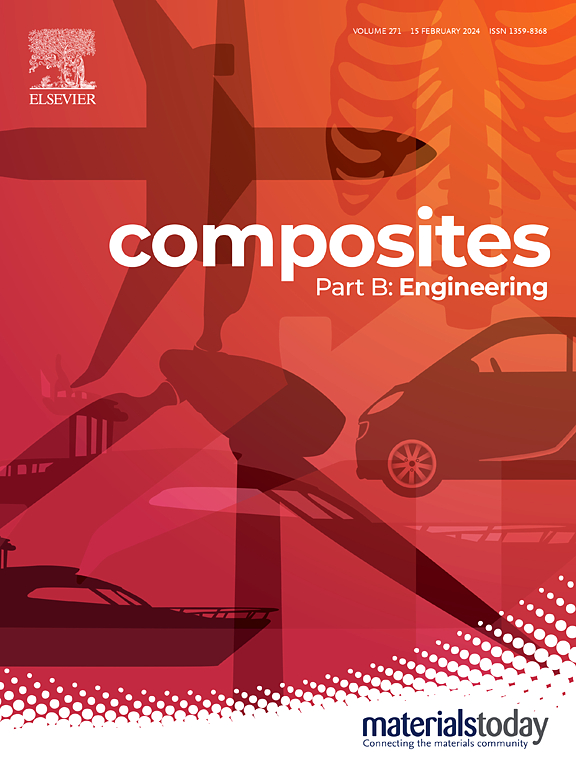Electrically conductive nanocomposites as heating elements for thermoplastics Joule welding
IF 14.2
1区 材料科学
Q1 ENGINEERING, MULTIDISCIPLINARY
引用次数: 0
Abstract
The potential of electrically conductive polycarbonate (PC) nanocomposites filled with carbon nanotubes (CNTs) and graphene nanoplatelets (GNPs) as heating elements to Joule weld PC substrates was investigated. Both GNPs/PC and CNTs/PC nanocomposites behaved as electrically percolated systems, with the CNTs rendering higher conductivities at considerably lower concentrations. Maximum values of 10.57 S/m and 0.028 S/m were achieved for the nanocomposite filled with 10 wt% loading of CNTs and 15 wt% loading of GNPs, respectively. The incorporation of 5 and 10 wt% loadings of CNTs into the polymer seemed to favour the development of denser conductive networks, capable of achieving the temperature required for an effective Joule welding of PC substrates under an applied voltage, whereas the addition of lower loadings of CNTs (i.e., ≤5 wt%) or GNPs at any loading ≤10 wt% rendered less conductive networks, not capable of achieving a high enough temperature for a successful Joule welding. The samples welded with the nanocomposite filled with 10 wt% CNTs showed higher lap shear strength (LSS) values (13.1–14.1 MPa) than those welded with the nanocomposite containing 5 wt% CNTs (12.3–12.9 MPa) due to the higher filler loading providing a higher conductivity and a more homogeneous Joule heating all throughout the heating element under the applied voltage. Likewise, increasing welding times, pressures and clamping distances led to progressively higher LSS of the Joule welded joints up to optimal values, with optimal times of 120 and 150 s being found for the nanocomposites containing 10 and 5 wt% loading of CNTs, respectively, and optimal pressure and clamping distance values of 1 MPa and 1.2 mm, respectively, being observed for both of them. This work demonstrates the potential of electrically conductive CNTs based polymer nanocomposites as heating elements for thermoplastics Joule welding, and highlights their formulation, applied voltage and welding parameters, including time, pressure and clamping distance, as key factors that can be strategically tuned to control the welding process and optimize the joints’ mechanical performance.

导电纳米复合材料作为热塑性塑料焦耳焊接的加热元件
研究了以碳纳米管(CNTs)和石墨烯纳米片(GNPs)填充的导电聚碳酸酯(PC)纳米复合材料作为焦耳焊接聚碳酸酯基板加热元件的性能。GNPs/PC和CNTs/PC纳米复合材料都表现为电渗透体系,CNTs在相当低的浓度下呈现更高的电导率。当CNTs和GNPs分别填充10 wt%和15 wt%时,纳米复合材料的峰值分别为10.57 S/m和0.028 S/m。在聚合物中加入5 wt%和10 wt%的碳纳米管似乎有利于形成更致密的导电网络,能够在施加电压下达到PC基板有效焦耳焊接所需的温度,而添加较低负载的碳纳米管(即≤5 wt%)或任何负载≤10 wt%的GNPs会产生较低的导电网络,无法达到成功进行焦耳焊接所需的足够高的温度。与含有5 wt% CNTs的纳米复合材料(12.3-12.9 MPa)焊接的样品相比,含有10 wt% CNTs的纳米复合材料焊接的样品显示出更高的剪切强度(LSS)值(13.1-14.1 MPa),这是由于更高的填料载荷提供了更高的电导率和在外加电压下整个加热元件更均匀的焦耳加热。同样,随着焊接时间、压力和夹紧距离的增加,焦耳焊接接头的LSS逐渐提高,直至达到最佳值,对于含有10 wt%和5 wt% CNTs的纳米复合材料,分别发现最佳时间为120和150 s,并且观察到两者的最佳压力和夹紧距离分别为1 MPa和1.2 mm。这项工作证明了导电碳纳米管聚合物纳米复合材料作为热塑性焦耳焊接加热元件的潜力,并强调了它们的配方、施加电压和焊接参数(包括时间、压力和夹紧距离)是可以战略性调整的关键因素,可以控制焊接过程并优化接头的机械性能。
本文章由计算机程序翻译,如有差异,请以英文原文为准。
求助全文
约1分钟内获得全文
求助全文
来源期刊

Composites Part B: Engineering
工程技术-材料科学:复合
CiteScore
24.40
自引率
11.50%
发文量
784
审稿时长
21 days
期刊介绍:
Composites Part B: Engineering is a journal that publishes impactful research of high quality on composite materials. This research is supported by fundamental mechanics and materials science and engineering approaches. The targeted research can cover a wide range of length scales, ranging from nano to micro and meso, and even to the full product and structure level. The journal specifically focuses on engineering applications that involve high performance composites. These applications can range from low volume and high cost to high volume and low cost composite development.
The main goal of the journal is to provide a platform for the prompt publication of original and high quality research. The emphasis is on design, development, modeling, validation, and manufacturing of engineering details and concepts. The journal welcomes both basic research papers and proposals for review articles. Authors are encouraged to address challenges across various application areas. These areas include, but are not limited to, aerospace, automotive, and other surface transportation. The journal also covers energy-related applications, with a focus on renewable energy. Other application areas include infrastructure, off-shore and maritime projects, health care technology, and recreational products.
 求助内容:
求助内容: 应助结果提醒方式:
应助结果提醒方式:


